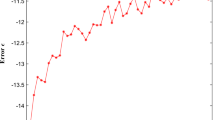Abstract
Many attitude estimation methods are based on an optimization problem posed in 1965 by Grace Wahba. All these methods yield the same optimal estimate, except for inevitable computer roundoff errors. This note shows shows that Shuster’s Quaternion Estimator (QUEST) and Mortari’s Estimator of the Optimal Quaternion (ESOQ) are essentially identical even in the presence of roundoff errors. It also shows some connections between two other algorithms for solving Wahba’s problem: Davenport’s q method and the Singular Value Decomposition (SVD) method.
Similar content being viewed by others
Notes
These satellites were designated HEAO-1,2,3; HEAO-1 was launched in 1978.
Mortari originally presented ESOQ’s computation of the optimal quaternion as the 4-dimensional cross product of three rows of H(λ m a x ), which is mathematically equivalent to the method presented here.
We employ the convention that x 1:0 or x 5:4 is an empty vector, with no components.
References
Wahba, G.: A least-squares estimate of satellite attitude. SIAM Review 7(3), 409 (1965)
Markley, F.L., Mortari, D.: Quaternion attitude estimation using vector observations. J. Astronaut. Sci. 48(2/3), 359–380 (2000)
Shuster, M.D., Oh, S.D.: Attitude determination from vector observations. J. Guid. Control 4(1), 70–77 (1981)
Mortari, D.: ESOQ: A closed-form solution of the Wahba problem. J. Astronaut. Sci. 45(2), 195–204 (1997)
Lerner, G.M.: Three-axis attitude determination. In: Wertz, J.R. (ed.) Spacecraft attitude determination and control. chap. 12. Kluwer Academic Publishers, The Netherlands (1978)
Markley, F.L.: Attitude determination using vector observations and the singular value decomposition. J. Astronaut. Sci. 36(3), 245–258 (1988)
Fallon III, L., Harrop, I.H., Sturch, C.R.: Ground attitude determination and gyro calibration procedures for the HEAO missions. In: 17th Aerospace Sciences Meeting, No. AIAA 79-0397, New Orleans, LA (1979)
Shuster, M.D.: The quest for better attitudes. J. Astronaut. Sci. 54(3/4), 657–683 (2006)
Horn, R.A., Johnson, C.R.: Matrix Analysis. Cambridge University Press, Cambridge (1985)
Golub, G.H., Van Loan, C.F.: Matrix Computations, 3rd ed. The Johns Hopkins University Press, Baltimore (1996)
Shuster, M.D., Natanson, G.A.: Quaternion computation from a geometric point of view. J. Astronaut. Sci. 41(4), 545–556 (1993)
Lefferts, E.J., Markley, F.L., Shuster, M.D.: Kalman filtering for spacecraft attitude estimation. J. Guid. Control. Dyn. 5(5), 417–429 (1982)
Shuster, M.D.: A survey of attitude representations. J. Astronaut. Sci. 41(4), 439–517 (1993)
Mortari, D.: Second estimator of the optimal quaternion. J. Guid. Control. Dyn. 23(5), 885–888 (2000)
Acknowledgments
I would like to acknowledge many valuable discussions of Wahba’s problem with Malcolm D. Shuster and Daniele Mortari. In particular, I want to thank Malcolm for suggesting the topic of this note. He intuited the equivalence of QUEST and ESOQ exactly as shown in this paper. I also want to acknowledge Yang Cheng’s critical contribution to the discussion of the singularity of QUEST for 180∘ rotations.
Author information
Authors and Affiliations
Corresponding author
Rights and permissions
About this article
Cite this article
Markley, F.L. Equivalence of Two Solutions of Wahba’s Problem. J of Astronaut Sci 60, 303–312 (2013). https://doi.org/10.1007/s40295-015-0049-x
Published:
Issue Date:
DOI: https://doi.org/10.1007/s40295-015-0049-x




